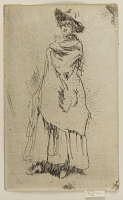The Little Cloak | ||
| Number: | 370 | |
| Date: | 1887 | |
| Medium: | etching | |
| Size: | 83 x 52 mm | |
| Signed: | no | |
| Inscribed: | no | |
| Set/Publication: | no | |
| No. of States: | 1 | |
| Known impressions: | 3 | |
| Catalogues: | K.336; M.332 | |
| Impressions taken from this plate (3) | ||
PUBLICATION
The Little Cloak was never published.
EXHIBITIONS
It was not exhibited in Britain, as far as is known. It was first shown in New York, by H. Wunderlich & Co. in 1903, and a year later an impression was lent by Frederick Keppel (1845-1912) to the comprehensive Whistler exhibition at the Grolier Club, New York. 13
13: New York 1903b (cat. no. 248); New York 1904a (cat. no. 340).
SALES & COLLECTORS
Whistler recorded two sales to Thomas M. McLean (b. ca 1832), who bought it under two titles - 'The Cloak' in 1887 and 'The Little Cloak' in 1888 - for £4.4.0 on each occasion. 14
Charles Lang Freer (1856-1919) bought one impression from Messrs Obach & Co. on 11 July 1903 ( ); this was said to come from the Cox collection, possibly that of James Cox-Cox (ca 1849- d.1901). Freer bequeathed it to the Freer Gallery of Art. Howard Mansfield (1849-1938) owned another, which was sold through A. A. Hahlo & Co., New York, to Harris G. Whittemore (d. ca 1937), and later acquired by the Library of Congress (
); this was said to come from the Cox collection, possibly that of James Cox-Cox (ca 1849- d.1901). Freer bequeathed it to the Freer Gallery of Art. Howard Mansfield (1849-1938) owned another, which was sold through A. A. Hahlo & Co., New York, to Harris G. Whittemore (d. ca 1937), and later acquired by the Library of Congress ( ). The third was bought by Lessing Julius Rosenwald (1891-1971), who gave it to the National Gallery of Art in 1943 (
). The third was bought by Lessing Julius Rosenwald (1891-1971), who gave it to the National Gallery of Art in 1943 ( ). Thus all three known impressions ended up in Washington DC.
). Thus all three known impressions ended up in Washington DC.
Charles Lang Freer (1856-1919) bought one impression from Messrs Obach & Co. on 11 July 1903 (
 ); this was said to come from the Cox collection, possibly that of James Cox-Cox (ca 1849- d.1901). Freer bequeathed it to the Freer Gallery of Art. Howard Mansfield (1849-1938) owned another, which was sold through A. A. Hahlo & Co., New York, to Harris G. Whittemore (d. ca 1937), and later acquired by the Library of Congress (
); this was said to come from the Cox collection, possibly that of James Cox-Cox (ca 1849- d.1901). Freer bequeathed it to the Freer Gallery of Art. Howard Mansfield (1849-1938) owned another, which was sold through A. A. Hahlo & Co., New York, to Harris G. Whittemore (d. ca 1937), and later acquired by the Library of Congress ( ). The third was bought by Lessing Julius Rosenwald (1891-1971), who gave it to the National Gallery of Art in 1943 (
). The third was bought by Lessing Julius Rosenwald (1891-1971), who gave it to the National Gallery of Art in 1943 ( ). Thus all three known impressions ended up in Washington DC.
). Thus all three known impressions ended up in Washington DC.
